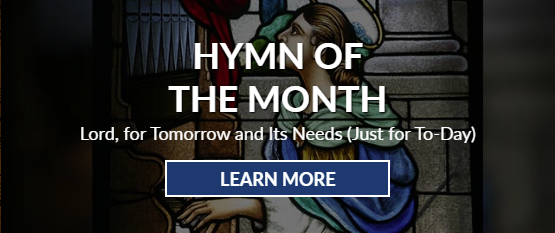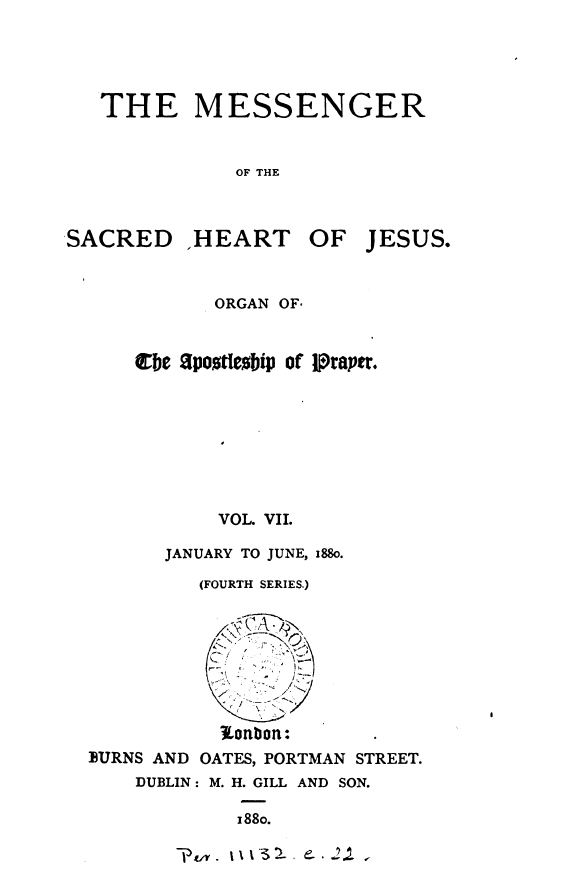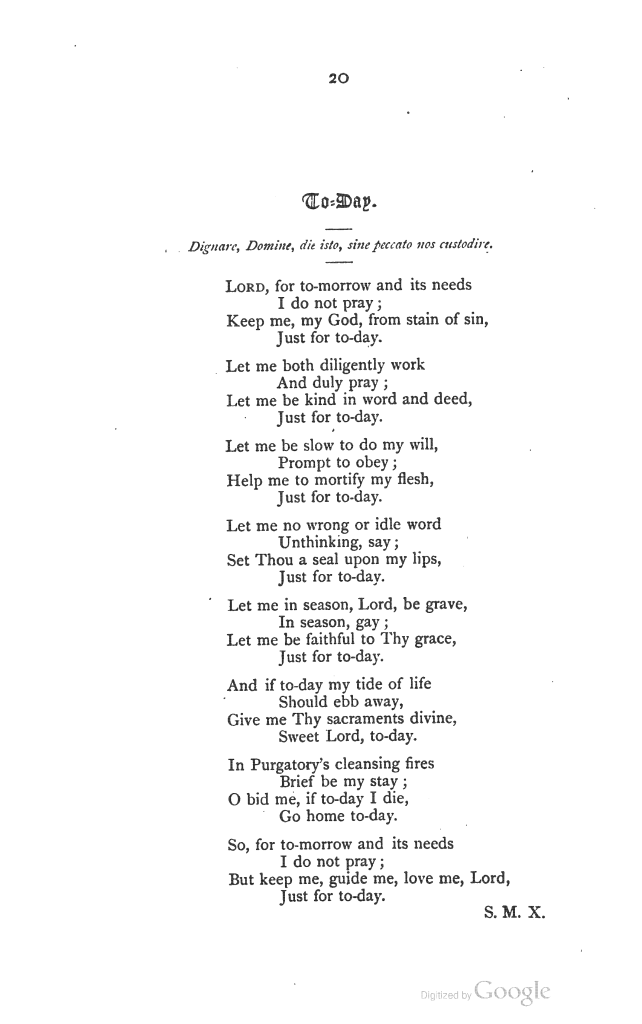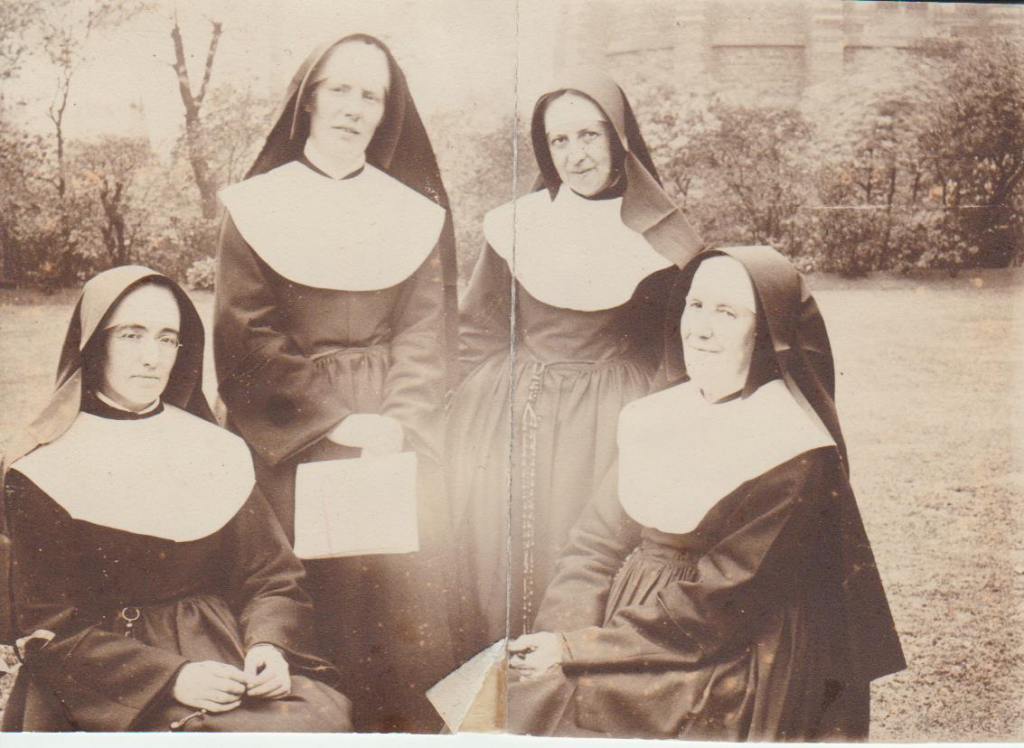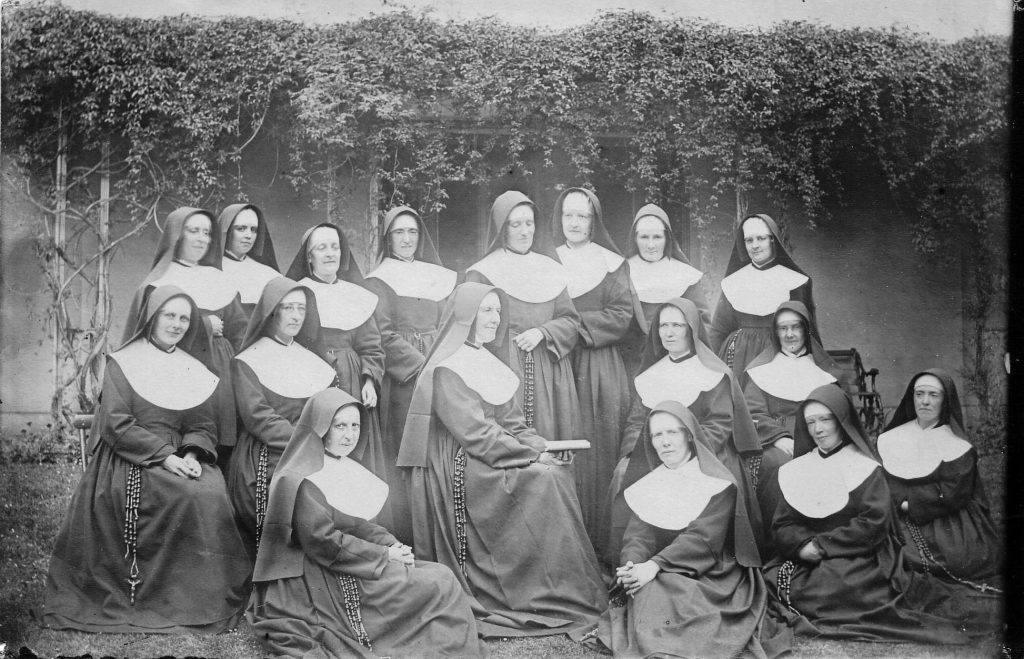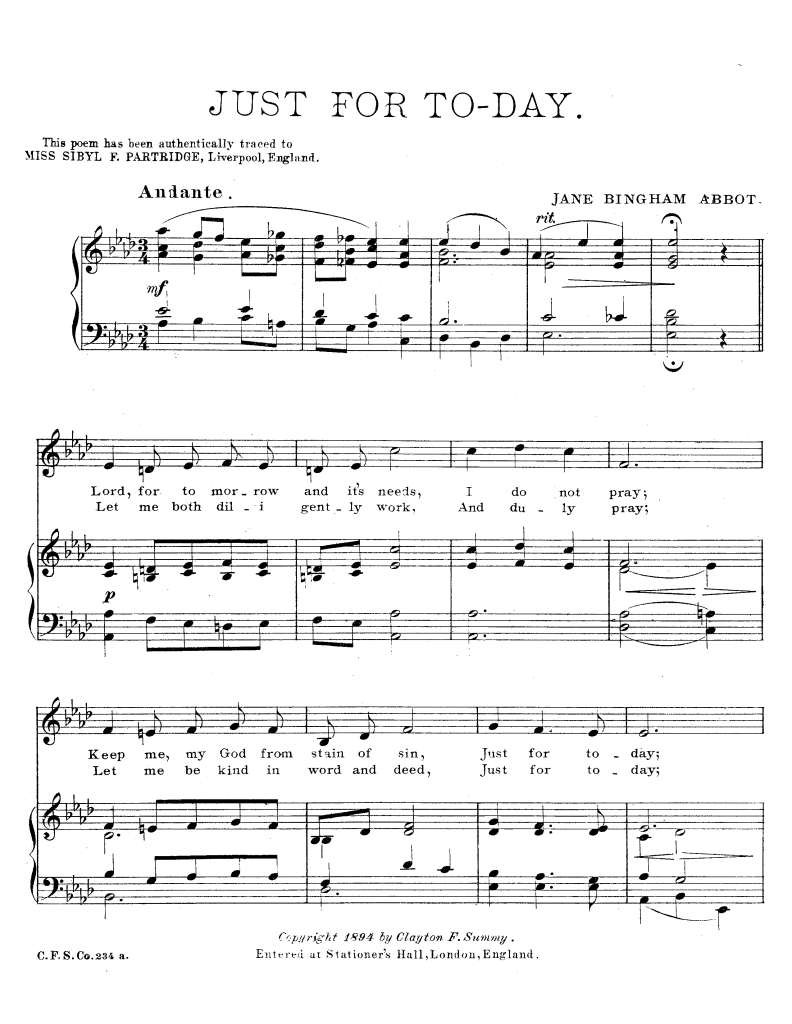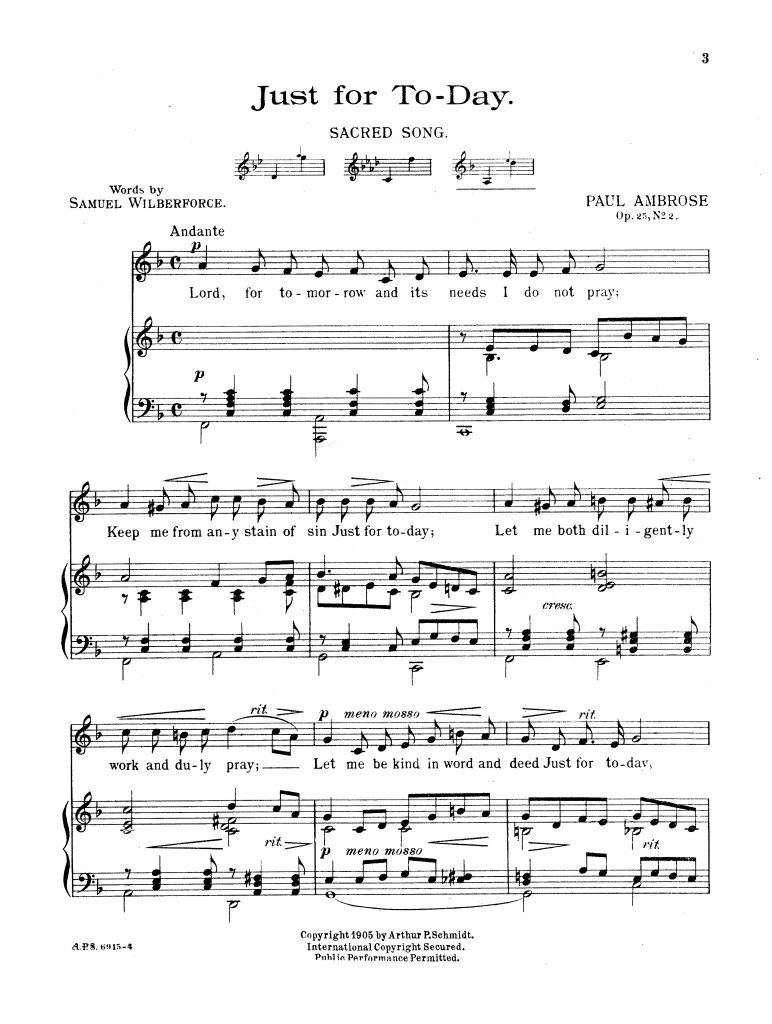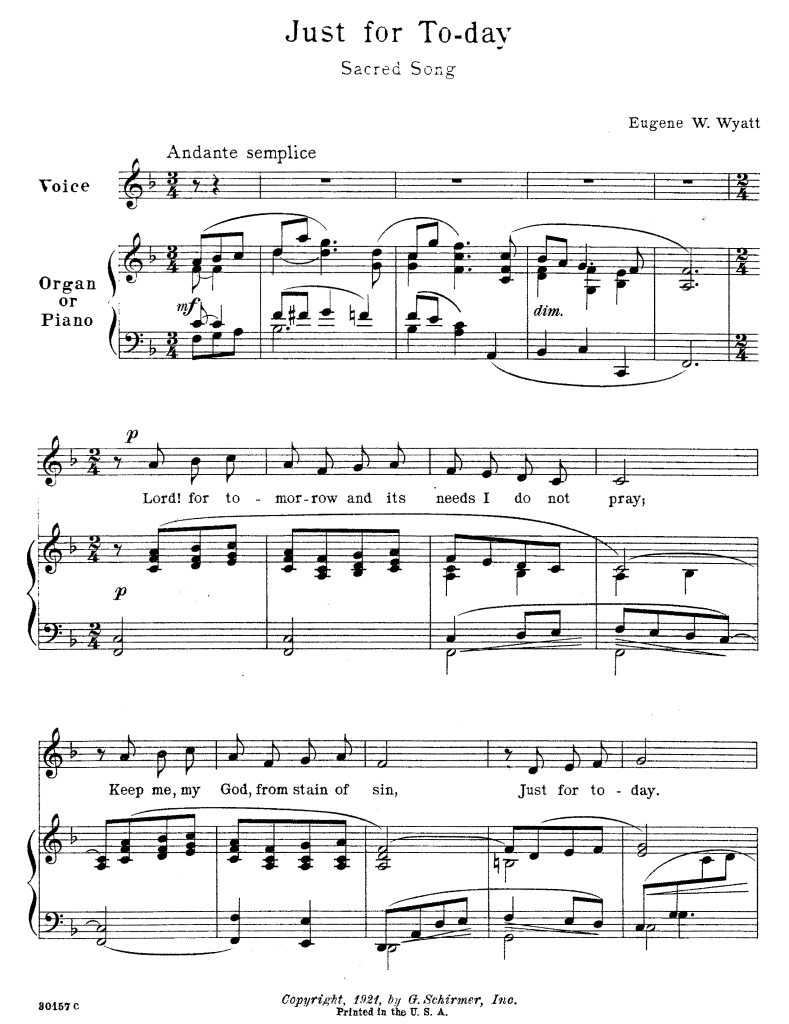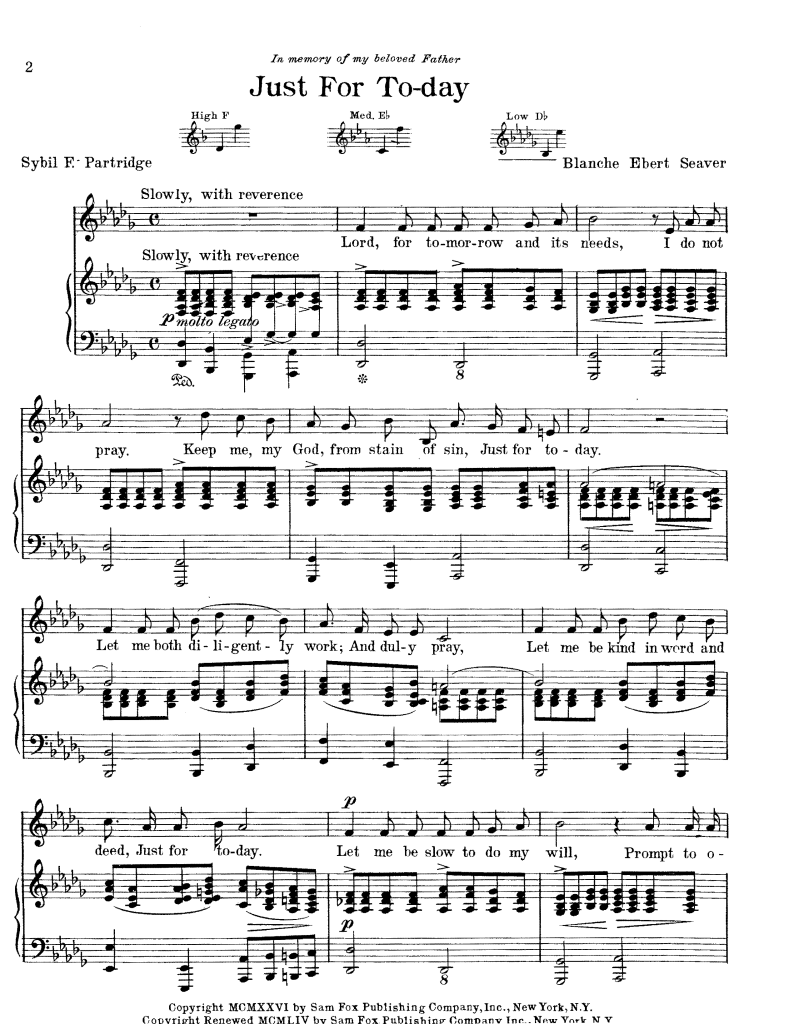The words of this hymn were written in the early morning hours of 1877 by Sister Mary Xavier while attending the bedside of an elderly nun whose life was ebbing away. The lines were of great comfort to the patient. In time, Sister Mary Xavier sent the words of the hymn to her mother, who had them published in the January issue of the MESSENGER OF THE SACRED HEART, 1880. This is the earliest known publication of the hymn to exist.
When conducting my research, I noted some inconsistencies found among the online sources with regards to Sister Mary Xavier, not the least of which is when she was born. So, I contacted the archivist of the Mount Pleasant Community in Liverpool, England to see if she could supply the correct biographical details of Sister Mary Xavier which she did.
Sister Mary Xavier was born Sybil F. Partridge on April 11, 1850, in London. Her father Professor Richard Partridge (1805-1873) was a London Doctor of Medicine and president of the Royal College of Surgeons. The family was distinguished for literary and artistic gifts. Three sisters entered Religion and died before Sister Mary Xavier. Her brother, Sir John Bernard Partridge (1861-1945), the famous cartoonist, joined the staff of Punch a British weekly magazine.
In 1873 Sybil Partridge offered herself as a Postulant at the Mother House of the Sisters of Notre Dame in Namur, Belgium. Not long after she was clothed in the Religious habit and took the name Sister Mary Xavier. In 1876 she made her Religious Profession at Namur, after which she was sent to the Convent of Notre Dame, Mount Pleasant, Liverpool. During this period, she also presented herself for examination gaining the Parchment which qualified her for teaching in the Training College. From the beginning of her career, she showed herself to be an exceptionally gifted teacher, and under the leadership of Sister Mary of St. Philip (Frances Mary Lescher) (1825-1904), contributed much to the fame of the Training College during the years she worked there.
In 1898 she became the first Principal of St. Mary’s Hall, a Secondary Training College opened in connection with the Notre Dame Convent, Mount Pleasant. In 1903, Sister Mary Xavier, at the request of former students and colleagues, published a book, IN HYMNIS ET CANTICIS, a collection of her poems, both sacred and profane.
The Mount Pleasant Community archivist supplied the above photos. The photo on the left captioned The Sisters of St. Mary’s Hall was marked with names on the back and if we accept that the naming is correct we have from left to right, Sister Julie of St. Agnes (Julie des Agnes), Sister Mary Xavier, Sister Rose of St. Joseph, and Sister Mary of St. Philip. The photo captioned Training College Sisters was not marked with any names. However, the four sisters who have been named already are in the second photo. Sister Mary of St. Philip is in the center (seated), in the first row on the left and right of Sister Mary of St. Philip and seated on the ground is Sister Rose of St. Joseph (left) and Sister Mary Xavier (right). Sister Julie of St. Agnes is seated in the second row, second from the left. The date of these photos is not known but were taken a few years apart and before 1904. Few photographs exist of the Sisters but clearly there were times when groups were photographed. Sisters were not usually allowed to have photographs taken until the late 1960s which makes these photographs incredibly special.
Sister Mary Xavier was twenty-seven years of age when she composed what was to become her most famous hymn. She composed as many as nineteen hymns and most of them appear in the NEW HYMNS by the Sisters of Notre Dame, published by Cary & Co., London circa 1892. Also in the AMERICAN CATHOLIC HYMNAL, 1913 and 1921, more than ten of Sister Xavier’s hymns appear in this one hymnal. Among the more widely used hymns of Sister Mary Xavier were her communion hymn Jesus, Thou Art Coming, her hymn Mother of Christ (Mater Christi), and Mother of all that is pure and glad (Causa Nostrae Laetitiae) also known as the Holiday Hymn.
In 1916, Sister Mary Xavier retired from Mount Pleasant and moved to Birkdale – part of the seaside town of Southport, just north from Liverpool. There was a good-sized community there for many years. Sister Mary Xavier died on February 23, 1917. She was buried in one of the Southport Catholic parish church graveyards.
The hymn appeared in the following Catholic hymnals: the 1912 and 1939 WESTMINSTER HYMNAL, a melody by Laurence or Lawrence Ampleforth, this is a pseudonym used by Richard R. Terry (1865-1938); the ST. BASIL’S HYMNAL, 1918 thru 1953, to a melody by James Edmund Jones; the ST. GREGORY HYMNAL, 1920, to a melody by Nicola Montani; the AMERICAN CATHOLIC HYMNAL, 1913 and 1921, to a melody by F. M. S. (Marist Brothers); in SELECTED HYMNS, 1930, a small book of hymns (words only) by the Sisters of St. Joseph of the Archdiocese of Boston; also in A DAILY HYMN BOOK, 1948, to a melody by Fr. F. M. de Zulueta, S.J.; the ALVERNO HYMNAL Part III, 1953, to a melody attributed to R. R. Terry and slightly altered; the MANUAL OF HYMNS FOR THE CATHOLIC SCHOOL, 1948 (words only) published especially for the Catholic Parochial Schools; and in the NEW ST. BASIL’S HYMNAL, 1958, to a melody by John Lee. Many of the hymnals listed above are available from the CCWATERSHED.ORG website.
The hymn is also found in many non-Catholic hymnals with melodies by various composers including Horatio R. Palmer (1834-1907), George C. Stebbins (1846-1945), and Thomas T. Noble (1867-1953). The authorship of the hymn has been pirated many times. Attributions to Bishop Samuel Wilberforce (1805-1873) and his son Bishop Ernest Wilberforce (1840-1907) both from the Church of England are commonly found in the hymnals. In an interview with Bishop Ernest Wilberforce about a month before he died, he denied any authorship to the hymn. Another name was William Huckle a convict from Dominion Penitentiary in Canada who claimed to have written the verses in a moment of inspiration. Being a character of more than unusual disreputableness William Huckle’s claim was dismissed. Some of the verses especially the Catholic verse beginning In Purgatory’s cleansing fires are left out of the non-Catholic hymnals.
The hymn appeared in sheet music form with music composed by several musicians. The first was composed by Jane Bingham Abbott published in 1894 by Clayton F. Summy Co. of Chicago and Weekes & Co., London and later sung by contralto Christine Miller on Edison records in 1914. Paul Ambrose (1868-1941) composed a melody in 1905 which was published by The Arthur P. Schmidt Co. of Boston. Between 1910 and 1921, several compositions were published by G. Schirmer, Inc., of New York. These include Mary Turner Salter (1856-1938) in 1910, Frederick Flaxington Harker (1876-1936) in 1914, and Eugene W. Wyatt (1880-1927) in 1921.
The melody that became the most widely used gained its great popularity through the 1930 film Song O’ My Heart, produced by the Fox Film Corporation and sung by the well-known Irish tenor John McCormack. Blanche Ebert Seaver (1891-1994) composed the music for the hymn in 1926. The melody by Blanche Seaver touched the hearts of many and its popularity grew. Baritone John Charles Thomas, accompanied by pianist Carroll Hollister, also sang Just For Today on Victor Red Seal records and radio during the 1930s and 1940s. Copies of the sheet music published by Sam Fox Publishing Company can be found on eBay.
In the CAECILIA magazine archives of the Church Music Association of America there is a wonderful write-up on the origins of the hymn and its author from which some of the details given in this story have been taken. You can read the full article in the November 1936 edition, page 445, captioned THE HYMN JUST FOR TODAY.
Reflection
During my earlier years in St. Mary’s Choir (1977-2010) this hymn was sung on various occasions before Mass by my friend and fellow tenor Tom McNeil (1933-2019). Over the years this prayerful hymn would find its way back to me, and I would hum the melody and sing the words that I once heard long ago. How wonderful to discover that the melody Tom sang was composed by Blanche Seaver and the words composed by Sister Mary Xavier. The verses reflect the words of Our Lord, Enough then, of worrying about tomorrow. Let tomorrow take care of itself. Today has troubles enough of its own (Matt. 6:34).
Another wonderful reflection of this hymn appeared in the CAECILIA magazine mentioned above in the article, WHAT QUALITIES SHOULD A GOOD HYMN HAVE? page 448. This review examines the following characteristics: Simplicity, Freshness, Reality of Feeling, Consistent Elevation of Tone, and A Rhythm Easy and Harmonious.
Simplicity – The more you enter those stanzas, the more you are enraptured by the childlike simplicity of a soul that trustfully longs for her God and of a soul that has, grasped the wonderful lesson of the Gospel: Be not solicitous for your life … Behold the birds of the air. Consider the lilies of the field. Be not solicitous for to-morrow (Matt. 6:25-34).
Freshness – Like a clear bubbling fountain these lines issue forth from the well-spring of a deep, loving heart. There is no laboring, digging and artificial hymn-smithing; the inspiration is right there, and the pen can hardly keep pace with the mental rapture; that’s why the World so eagerly has taken to these verses.
Reality of feeling – What is more real than death? And what is more certain than that the present day may be our last one? If under pressure of this awful reality, the soul embraces her God with every fiber. Can anyone say that these lines are destitute of sound feeling?
Consistent elevation of tone – There is no monotony in these lines; one mental vista seems to chase the other; the sanctified daily routine of cloistered life: Work and pray and obey and deny thyself’ passes quickly before our mental gaze; we hold our breath and admit that the program of every Christian is held up before our eyes.
A rhythm easy and harmonious – Easy, yes, it is easy, not labored rhythm; it is playful, joyful, inviting, and for this reason it is harmonious rhythm: it is music for the soul, inspiration for the mind, a vigorous incentive for the will.
The hymn Lord, for Tomorrow and Its Needs appears in A Catholic Book of Hymns published by the Sacred Music Library. This is a wonderful collection of 295 time-honored Catholic traditional hymns.
Newly commissioned recordings of some of the hymns written by Sister Mary Xavier can be found by visiting the Devotional Hymns Project website produced by Peter Meggison. Look for these hymns written by Sister Mary Xavier:
- Jesus, Thou Art Coming
- Mother of Christ
- Mary, O Turn Thine Eyes Upon Us
- Fierce and Loud is the battle raging
- Lord, for Tomorrow and Its Needs
- Mother! Mother! I’m Coming Home
- O Lord of Host
- O King and Lord
- Nunc et in hora mortis
- Heart of Jesus! Sacred Heart!
- Queen and Mother
Visit the Devotional Hymns Project website often because new recordings of Catholic devotional hymns are always being added.

